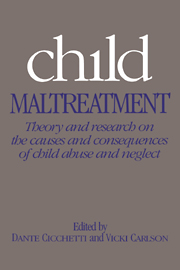Book contents
- Frontmatter
- Contents
- List of contributors
- Preface
- Part I History and definition
- Part II Parental and contextual influences on maltreatment
- 6 Lessons from child abuse: the determinants of parenting
- 7 The antecedents of maltreatment: results of the Mother–Child Interaction Research Project
- 8 Parental attributions as moderators of affective communication to children at risk for physical abuse
- 9 Perceived similarities and disagreements about childrearing practices in abusive and nonabusive families: intergenerational and concurrent family processes
- 10 Cognitive foundations for parental care
- 11 Intergenerational continuities and discontinuities in serious parenting difficulties
- 12 The construct of empathy and the phenomenon of physical maltreatment of children
- Part III The developmental consequences of child maltreatment
- Name index
- Subject index
12 - The construct of empathy and the phenomenon of physical maltreatment of children
Published online by Cambridge University Press: 04 May 2010
- Frontmatter
- Contents
- List of contributors
- Preface
- Part I History and definition
- Part II Parental and contextual influences on maltreatment
- 6 Lessons from child abuse: the determinants of parenting
- 7 The antecedents of maltreatment: results of the Mother–Child Interaction Research Project
- 8 Parental attributions as moderators of affective communication to children at risk for physical abuse
- 9 Perceived similarities and disagreements about childrearing practices in abusive and nonabusive families: intergenerational and concurrent family processes
- 10 Cognitive foundations for parental care
- 11 Intergenerational continuities and discontinuities in serious parenting difficulties
- 12 The construct of empathy and the phenomenon of physical maltreatment of children
- Part III The developmental consequences of child maltreatment
- Name index
- Subject index
Summary
Introduction
Empathy and child abuse, seemingly disparate concepts, are both topics of contemporary concern to professionals and lay individuals. Although each has its own extensive history, current interest in the two topics revived in the sixties and has grown dramatically since then.
The composition and functions of the empathic response were once questions that philosophers and artists debated. With the development of Rogerian theory and therapy, the psychotherapeutic role of empathy was discussed and efforts were initiated to assess this complex psychological dimension (Dymond, 1949; Rogers and Truax, 1967). During the sixties and seventies, developmental and personality theorists broadened the arena of discourse and, more importantly, developed situational and self-report measures of empathy (Borke, 1971; Chandler, 1973; Feshbach and Roe, 1968; Hogan, 1969; Mehrabian and Epstein, 1972) that substituted for the earlier approaches that were more difficult to interpret.
It was also during the decade of the sixties that Kempe and his colleagues reminded us of the plight of the maltreated child, especially the physically abused child, with his papers on the battered child syndrome (Kempe, Silverman, Steele, Droegemueller, and Silver, 1962). The writings of de Mause (1974) and others sadly attest to the fact that child abuse is an age-old malpractice rather than a current aberration. Yet research findings, public concern, and the frequency of reported cases of child abuse have only really become salient during the last twenty years.
- Type
- Chapter
- Information
- Child MaltreatmentTheory and Research on the Causes and Consequences of Child Abuse and Neglect, pp. 349 - 374Publisher: Cambridge University PressPrint publication year: 1989
- 22
- Cited by

